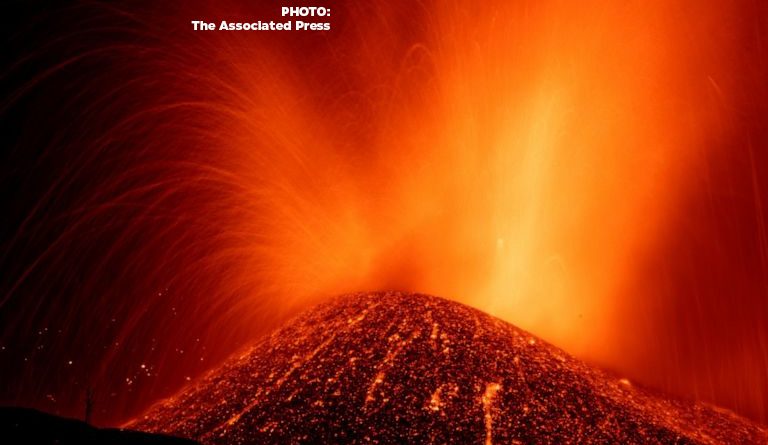La lava ocupa 166 hectáreas en La Palma
Santa Cruz de la Palma (España), 23 sep (EFE).- La lava arrojada por el volcán de Cumbre Vieja en la isla canaria de La Palma cubre ya más de 166 hectáreas y ha destruido 350 inmuebles, según los últimos datos del sistema de observación terrestre europeo Copernicus, obtenidos en la tarde de ayer.
Las mediciones, hechas a las 19:26 horas de ayer, muestran cómo la lava había cubierto 14 hectáreas más que en la anterior, efectuada 36 horas antes, y había arrasado 30 inmuebles más que los contabilizados el día anterior.
El último informe del Departamento de Seguridad Nacional (DSN), emitido a las 08:00 de esta mañana, reduce ligeramente esa estimación hasta las 150 hectáreas y los 300 inmuebles destruidos.
Confirma además que se mantiene la actividad eruptiva aunque el volcán de La Palma, isla del archipiélago atlántico de Canarias, ha entrado en zona de estabilidad y la velocidad de desplazamiento de las coladas hacia la costa se ha aminorado, de modo que la más activa, la norte, avanza a 4 metros por hora.
No obstante los frentes de avance de la lengua han crecido en altura y se sitúan ahora entre los 8 y los 15 metros. EFE
Lava spread raises fears of more damage on Spanish island
The advance of lava from a volcanic eruption in Spain’s Canary Islands has slowed significantly
By RENATA BRITO and BARRY HATTON Associated Press
23 September 2021, 07:52
TODOQUE, Canary Islands — The advance of lava from a volcanic eruption in Spain’s Canary Islands has slowed significantly, raising fears Thursday that it might fan out further across the land and destroy more homes instead of flowing into the sea.
A giant river of lava 600 meters (2,000 feet) wide slowed to four meters (13 feet) per hour after reaching a plain on Wednesday. On Monday, a day after the eruption on the island of La Palma, it was moving at 700 meters (2,300 feet) per hour.
Stavros Meletlidis, a volcanologist at Spain’s National Geographic Institute, said the dynamics of any eruption were in constant flux.
“The lava is advancing very slowly because it cools in contact with the atmosphere, through friction with the ground and building materials and, above all, because its front edge is widening out,” he told Radio Televisión Canaria.
As it slowed, the lava also grew thicker. In places, it rose up to 15 meters (50 feet) high, authorities said. The lava now covers 166 hectares (410 acres) and has swallowed up around 350 homes.
The lava’s slowing pace bought time for more residents of towns in its path to grab belongings, with the Guardia Civil police force escorting them to their homes in Todoque, close to the coast, on Thursday morning.
The Guardia Civil said seismic activity in the area, which surged before the eruption and has remained strong, has stabilized.
But molten lava, ash and smoke continued to pour from the volcano’s mouth, shooting up to 4,200 meters (nearly 14,000 feet) high, the Canary Islands Volcanology Institute said. That raised concerns about whether airspace above the island could remain open.
ENAIRE, which manages Spain’s airspace, said two areas above the affected area are being declared no-fly zones to allow emergency services to operate freely. Many flights into and out of La Palma were delayed early Thursday.
Volcanic ash can be dangerous for aircraft. It can also cause respiratory problems, as well as potentially being an irritant for the eyes and skin.
The Emergency Military Unit deployed on the island said the readings it has taken of the air found no threat to health.
Authorities haven’t reported any casualties from the eruption, though damage to property, infrastructure and farmland is expected to be significant.
Scientists were monitoring the volcano activity and had warned of a possible eruption. That allowed almost 7,000 people to be evacuated in time.
Spain’s King Felipe VI and Queen Letizia, and Prime Minister Pedro Sánchez, visited La Palma on Thursday and met with some of those made homeless.
Officials had initially expressed fears about what would happen when the lava reached the Atlantic Ocean. The lava, whose temperature exceeds 1,000 C (more than 1,800 F), could cause explosions, trigger landslides and produce clouds of toxic gas when it hits the ocean, experts say.
The eruption and its aftermath could last for up to almost three months, according to the Volcanology Institute.
Life on the rest of La Palma, which is roughly 35 kilometers (22 miles) long and 20 kilometers (12 miles) wide at its broadest point, has been largely unaffected, with undeterred tourists landing for previously scheduled vacations.
The Canary Islands are a popular destination for European tourists due to their mild year-round climate.
The islanders mostly live from farming and tourism.


 (1) (2).jpg)

